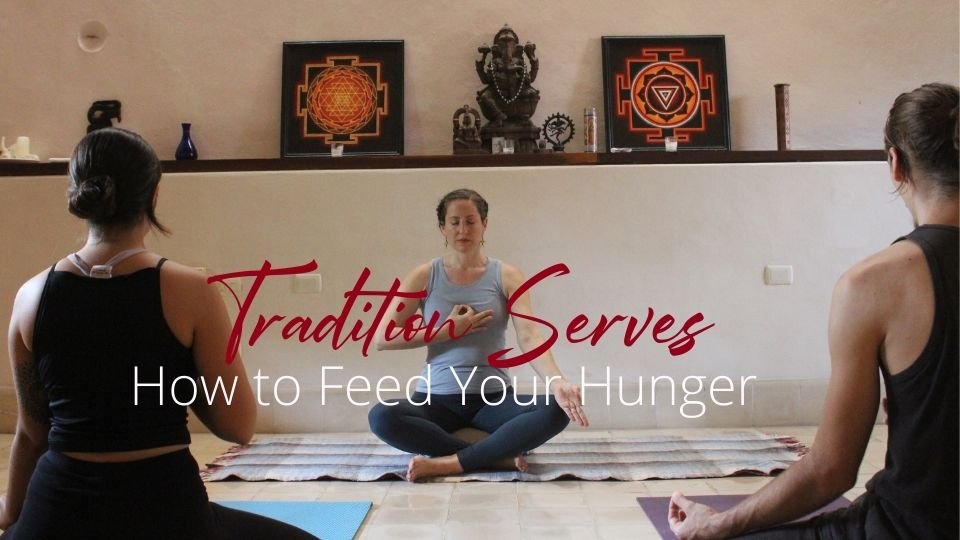When we are very hungry, taking only a spoonful of a meal can make us lose our ravenous minds.
However, if we know that there is a kitchen full of grandmothers cooking in the old ways, we can be at peace with the pits in our bellies. Because when they are done — and it will be in their own time — we will eat very well.
Don’t Look Back
In the West we are at odds with the old ways. We think of ancient mysteries as painstakingly complicated dishes that must be — insert eye roll — passed down orally because everyone’s grandmother made it by heart.
But the further we have moved away from the origins of our hearts, the more we have forgotten to ask our grandmothers what they know. Starving for wisdom, we call up a 25-year-old coach who seems to have it all figured out and ask how to make sense of this wild world.
The Great Debate
Perhaps the reason the West has turned away from tradition is that our cultures are new and were born of dissent. We tore the towers down because the old ways were warped into tools to quiet the hungry masses. Rightfully so, yet, sitting in the pile of rubble, we are realizing how terribly hungry we are.
Many of us living in the West are now turning back toward practices and beliefs that our ancestors actively sought to stamp out. In doing so, we draw the line of our trajectory into tremendous tension. None of us is sure how much load it can bear.
As we tug further, the question that drives us is whether to blindly follow the old ways or bow to the goddess of ingenuity. But I’d like to offer a different perspective, one that acknowledges that in all A or B questions, there is always a third option.
But before I share what this answer is, we’re going to explore hunger.
How to Get Full
Whether or not we know it, many inspirational memes on the internet and New Age teachings get their light by mirroring a brilliant fire that has burned for centuries. The source is the wisdom traditions. These have existed on every continent, and though many practices have been wiped out, wisdom traditions cannot be killed.
A wisdom tradition is any teaching or practice that offers universal clarity and would be easily named by some great-great grandmother somewhere. Wise traditions, just like the grandmothers’ meals, leave us licking our lips with satisfaction.
Because wisdom cannot die but is largely not free to live, it is often hidden in plain sight. The teachings are woven like fine gold threads into myth and fairy tales. Their faint scent appears in religious ceremonies. They fall like broken shards of glass from the babbling tongues of the women who have lived forever.
We don’t notice all these dropped hints because we are sitting around the fires of our glowing screens, in awe of what we’ve created. And rightly so — we’ve gone from lying on dirt floors to soft, warm beds in just a few generations. Our Dick Tracy watches and spinning satellites give us a taste of what it must be like to identify completely with the source of all creation.
But as we’ve been finding, creation is only satisfying if it grows from deep roots. Otherwise, we are feasting on air.
The Way Home
One of the greatest challenges about approaching wisdom traditions is that they are laid out for us in a Las Vegas-style buffet — there are a thousand paths to fill your hunger and it’s easy to overdo it. Most people sample a little of everything. But this just leaves you bloated, overwhelmed, and utterly confused.
This sampling effect is why the meme-friendly statements and New Age quips seem right at first, but vanish into thin air when you try to pin them down. Truth, the language of wisdom traditions, is heavy. It sticks to our ribs and is pleased to serve us whenever we get that empty feeling in our bellies — because no matter how much we fill up at a meal, we will be hungry again.
Shall We Dance?
Most people are drawn to something wise, even if it is a passing, fleeting affair. Though people rarely get to choose which particular wisdom tradition they fall for. Instead, the wisdom draws us in, like a seductive dance partner we cannot resist.
You may find your wisdom tradition emerging from your cultural background, or it may come from parts of the world from which you did not descend. The trap — also called cultural appropriation — is when we perform what we think wisdom and/or tradition look like. Instead, listen first and know less. Genuinely seek solace and refuge and you’ll be walking home, no matter which direction you are coming from.
The Third Way
There is no doubt that most people living in the Western world are in a state of painful hunger. If you don’t believe me, just look at the rates of people on prescription antidepressants. If that doesn’t prove it to you, look at the number of people in drug or alcohol recovery (or still steeped in abuse). This is a hunger that has become so chronic that many people cannot identify it — they just live with the emptiness.
In our thirst for innovation, we have discovered incredible things. We have learned how to educate people en masse and hold oceans of information in our pockets. We have built roads, airplanes, and telescopes that expand our once tiny scope. This virtual exchange exists because our culture values new things over the old. As we bow to that, we must remember that there is no way for an individual to grow up when a culture lacks respect for the dirt that held us.
Which is why we need a third way.
In the style of the wisdom traditions, I’ll share the teaching of the third way simply and obscurely: To be grounded in wise tradition is to point ourselves toward mastery. Here we build, rooted in a foundation that has already been laid. Yet even the masters know that anything we pass on as tradition is just a series of innovations.
The Wise Way
Before you go digging through the relics for a golden chalice, understand that not everything that is old is necessarily wise. Likewise, before you line up every time a new version is released, remember that the quest for novelty is a groundless addiction.
If you are hungry — and I know you are — sink your teeth into something real. Let the taste roll over your tongue and warm your belly. Give yourself over to being satiated in a way that will only come from a meal that has been passed down in an unbroken chain of a thousand smiling grandmothers. You will be that grandmother one day, and your hungry children will count on you to have made that recipe your own.





